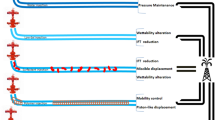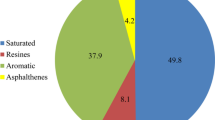Abstract
Recently, nanoparticles have become an attractive agent for enhanced oil recovery (EOR). Because much of the work on nanoparticles for enhanced oil recovery is still at the laboratory stage and to gain a better understanding of this technique, it is essential to study the effect of nanoparticles on EOR. In addition, the world is now more environmentally aware, presenting the opportunity to use biosurfactants for EOR. In this paper, the synergistic effect of biosurfactant and nanoparticles on the removal of oil in a glass micromodel was evaluated. In this study, an aqueous solution of emulsan biosurfactant with addition of SiO2 nanoparticles was used as a nanofluid. The emulsan biosurfactant was produced by Acinetobacter calcoaceticus PTCC1318. The production of emulsan was confirmed by FTIR and 1H NMR analysis. According to our results, the use of the mixture of biosurfactant and nanoparticle (nanofluid) permitted a 90% reduction of interfacial tension in comparison with biosurfactant solution alone. Micromodel oil displacement experiments with kerosene showed around 10 and 20% recovery of residual oil after water flooding when the emulsan and nanofluid were injected, respectively. These results are useful in extending the application of nanostructures in ex situ microbial enhanced oil recovery.







Similar content being viewed by others
References
Cheraghian G, Hemmati M, Masihi M, Bazgir S. An experimental investigation of the enhanced oil recovery and improved performance of drilling fluids using titanium dioxide and fumed silica nanoparticles. J Nanostruct Chem. 2013;3:78–87.
Sen R. Biotechnology in petroleum recovery: the microbial EOR. Prog Energy Combust Sci. 2008;34:714–24.
Amani H, Sarrafzadeh MH, Haghighi M, Mehrnia MR. Comparative study of biosurfactant producing bacteria in MEOR applications. J Pet Sci Eng. 2010;75:209–14.
Joonaki E, Ghanaatian S. The application of nanofluids for enhanced oil recovery: effects on interfacial tension and coreflooding process. J Pet Sci Technol. 2014;32:2599–607.
Hendraningrat L, Li S, Torsæter O. A coreflood investigation of nanofluid enhanced oil recovery. J Pet Sci Eng. 2013;111:128–38.
Suleimanov BA, Ismailov FS, Veliyev EF. Nanofluid for enhanced oil recovery. J Pet Sci Eng. 2011;78:431–7.
Zargartalebi M, Kharrat R, Barati N. Enhancement of surfactant flooding performance by the use of silica nanoparticles. Fuel. 2015;143:21–7.
Munshi AM, Singh VN, Mukesh Kumar, Singha JP. Effect of nanoparticle size on sessile droplet contact angle. J Appl Phys. 2008;103:084315.
Amani H, Müller MM, Syldatk C, Hausmann R. Production of microbial rhamnolipid by Pseudomonas aeruginosa MM1011 for ex situ enhanced oil recovery. Appl Biochem Biotechnol. 2013;170:1080–93.
Pereira JFB, Gudi˜na EJ, Costa R, Vitorino R, Teixeira JA, Coutinho JAP, Rodrigues LR. Optimization and characterization of biosurfactant production by Bacillus subtilis isolates towards microbial enhanced oil recovery applications. Fuel. 2013;111:259–68.
Kaplan N, Rosenberg E. Exopolysaccharide distribution of and bioemulsifier production by Acinetobacter calcoaceticus BD4 and BD413. Appl Environ Microbiol. 1982;44:1335–41.
Amani H, Mehrnia MR, Haghighi M, Sarrafzadeh MH, Soudi MR. Scale up and application of biosurfactant from Bacillus subtilis in enhanced oil recovery. Appl Biochem Biotechnol. 2010;162:510–23.
Rahman PKSM, Gakpe E. Production, characterisation and applications of biosurfactants—review. Biotechnology. 2008;7:360–70.
Amani H. Study of enhanced oil recovery by rhamnolipids in a homogeneous 2D micromodel. J Pet Sci Eng. 2015;128:212–9.
Mao X, Jiang R, Xiao W, Yu J. Use of surfactants for the remediation of contaminated soils: a review. J Hazard Mater. 2015;285:419–35.
Su WT, Chen WJ, Lin YF. Optimizing emulsan production of A. venetianus RAG-1using response surface methodology. Appl Microbiol Biotechnol. 2009;84:271–9.
Komesvarakul N, Sanders MD, Szekeres E, Acosta EJ, Faller JF, Mentlik T, Fisher LB, Nicoll G, Sabatini DA, Scamehorn JF. Microemulsions of triglyceride-based oils: the effect of co-oil and salinity on phase diagrams. J Cosmet Sci. 2006;55:309–25.
Nordiyana MSW, Khalil M, Jan BM, Ali BS, Tong CW. Formation and phase behavior of Winsor type III Jatropha curcas—based microemulsion systems. J Surfactants Deterg. 2016;19:701–12.
Author information
Authors and Affiliations
Corresponding author
About this article
Cite this article
Amani, H. Synergistic Effect of Biosurfactant and Nanoparticle Mixture on Microbial Enhanced Oil Recovery. J Surfact Deterg 20, 589–597 (2017). https://doi.org/10.1007/s11743-017-1943-y
Received:
Accepted:
Published:
Issue Date:
DOI: https://doi.org/10.1007/s11743-017-1943-y




